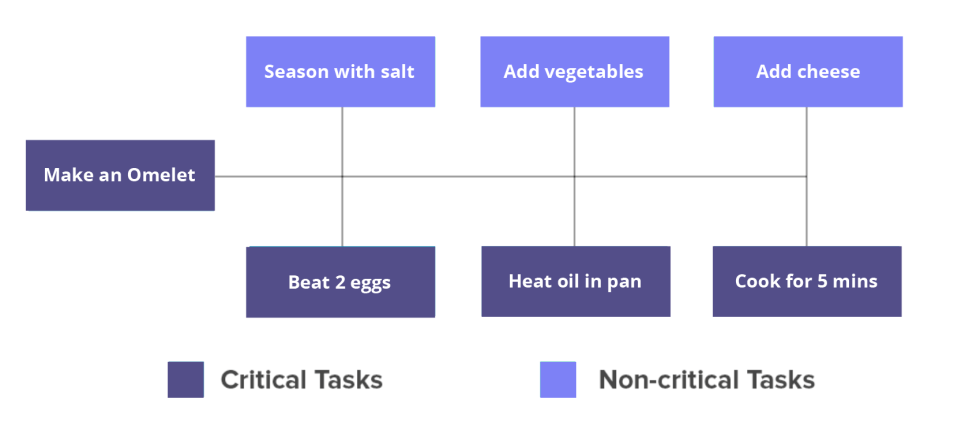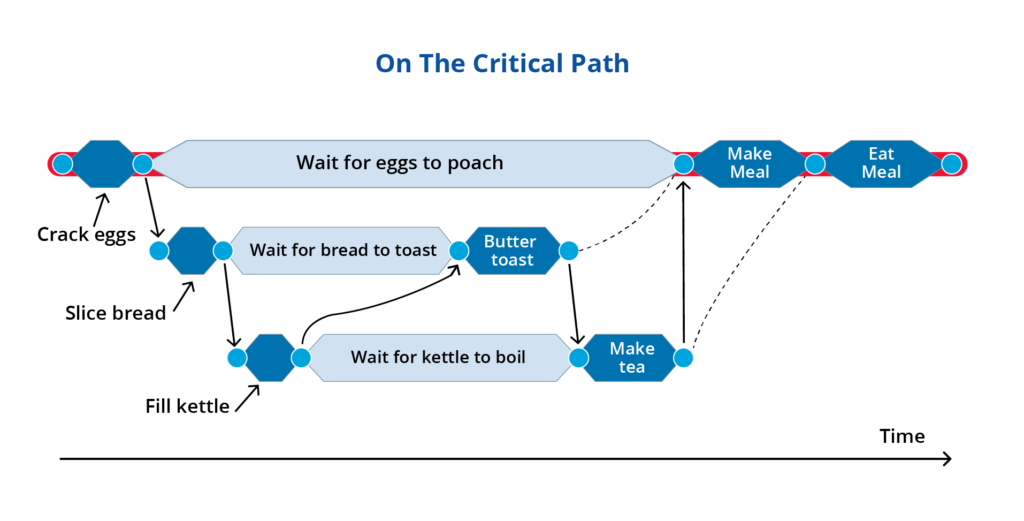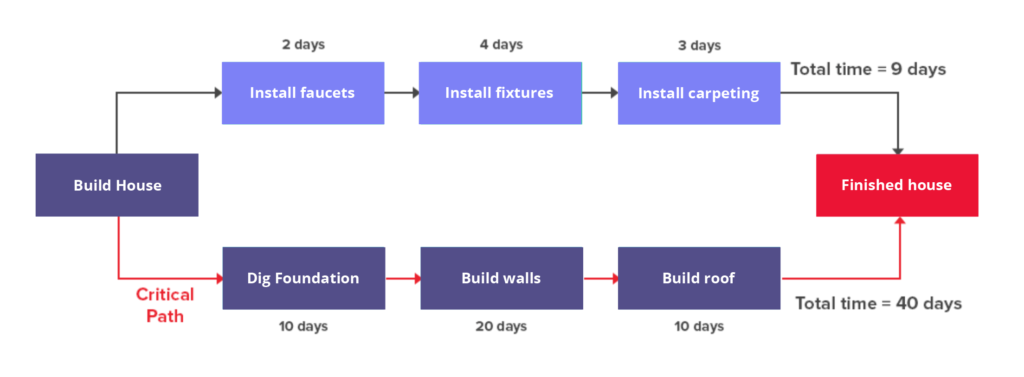Project Management Guide
Project Management Guide
What Is Project Management?
What Is a Project?
Why Is Project Management Important?
Project Life Cycle Phases
- Project Initiation
- Project Planning
- Project Execution
- Project Monitoring
- Project Closure
Project Management Methodologies
- Waterfall Project Management
- Critical Path Method
- Critical Chain Project Management
- Agile Project Management
- Scrum Project Management
- Kanban Project Management
- Lean Project Management
- Six Sigma Project Management
- PRINCE2
- PRiSM
- PMBOK Method
Project Management FAQ
A Complete Guide to the Critical Path Method of Project Management
Ever find yourself making ‘guestimates’ when it comes to important task deadlines and milestones instead of making real-time updates to your overall project plan?
This is one of the most common mistakes project managers end up making with the critical path analysis method. The Project Management Body of Knowledge (PMBOK) defines this method as follows:
“The Critical Path Method is the sequence of scheduled activities that determines the duration of the project.”
Put simply, the tasks in the ‘Critical Path Method’ (CPM) cannot be initiated until the previous tasks are complete. Think of it as stringing the longest sequence of pearls (or in this case, the tasks and events) into a necklace (a.k.a critical path). Every piece is dependent on each other from start to finish to give you the desired end-result.
This project scheduling technique was developed by Morgan R. Walker and James E. Kelly in the late 1950s and is extensively used along with Gantt charts.
Did you know?
This project management technique was used to execute the Manhattan Project.
Let’s take a look at an interesting example to understand the critical path for making a ‘good’ versus an ‘okay’ omelet:

Here are the key points to note:
- The three steps listed below form the ‘critical’ tasks without which you will not be able to make an omelet at all. It is also essential to note that the task must be completed in the specified order to get an omelet.
- The three steps listed above form the ‘add-ons’ or non-critical tasks to the core steps, which further enhance the end result. Remember that even if you don’t end up performing these tasks, the project will get completed in time.
Let’s take a look at another example:

- In this example, Tim Tyler suggests that poaching the egg becomes the critical path or the constraining factor, whereas activities such as toasting the bread and boiling the water constitute as slack/float/free time. Basically, the latter double up as parallel paths/tasks that can be completed simultaneously using additional resources and fast-tracking the process.
Advantages of Critical Path Activities
“For me, the biggest advantage of the critical path method is that it makes risk assessment easy. If I’ve got dependencies laid out and plans change, it’s very easy to say, ‘Because you missed that deadline, the next deliverable is going to be late by X days, and that puts us beyond our plan by Y days.’ Simple. That said, I don’t think you have to fully adopt a method like the critical path to do this on projects. It’s best to adopt the parts of any method that work for your project and your team—being adaptable as a PM (project manager) will help you find true success.” – Brett Harned, digital project management consultant, writer, speaker, and community builder. When it comes to tackling complex projects, the critical path method offers a host of benefits. It is especially useful for tasks where the activity duration is easy to predict.
The main objective of the critical path method: To calculate the shortest amount of time required for sequencing the longest path of interconnected tasks that are integral to the project completion date.
The primary advantages of using this method include (but are not limited to):
- Prioritizing tasks: You can define and simplify essential and non-essential tasks on the path in a visual manner, which is easy to comprehend.
- Preventing delays: You can prioritize tasks effectively and allot the time required to complete the project, keeping in mind the longest sequence possible.
- Enhancing productivity: The CPM (critical path method) helps to allocate resources optimally.
- Optimizing efficiency: It allows you to reschedule low-priority tasks, thereby freeing up the team’s bandwidth.
- Tracking and managing tasks efficiently: You can make modifications to the project schedule and track the progress in real-time.
“The critical path method brings an important level of clarity to your project. It is a visual depiction of the fragility of the balance of your constraints: If one of the activities on the path gets delayed, your project gets delayed. It is also a great way to determine where to invest resources if the project has fallen behind schedule.” – Cesar Abeid, host of the Project Management for the Masses Podcast
Disadvantages of the Critical Path Method
- Like with most planned schedules, delays and bottlenecks are commonplace. And as such, this method does not factor in the same.
- Additionally, it also does not take into account in-depth details with respect to people, resources, and budget.
- Estimating task durations with exacting precision can be difficult.
Creating a Critical Path: The Basics
Step 1: You specify the activities and project deliverables using the work breakdown structure (WBS) and detail the longest sequence possible.
Expert tip: Try making the WBS as detailed as possible as it serves as the foundation of your critical path.
Step 2: List the dependent and concurrent tasks and identify which tasks depend on each other to create an activity sequence.
Handy tip: To stay ahead of task priority, project managers should track each task progression as the team goes about performing it.
Step 3: Next, you need to create a critical path analysis chart based on the tasks identified along with the dependencies. To get started, first make a list of the activity sequences and create different boxes for each task. You also need to put in arrows to signify the task dependency.
Step 4: Figure out the longest time duration for each activity. You can use data from experience and knowledge, past projects, or industry benchmarks to arrive at a satisfactory number. Alternatively, you can take the average of the following three cases to arrive at an accurate project time estimate:
- Ideal-case scenario or the shortest duration (A)
- Normal scenario or the expected duration (B)
- Worst-case scenario or the longest duration (C)
- Activity Duration = A + B + C / 3
That’s not all. You can also use the Forward Pass/Backward Pass technique, earliest start and finish times, and the latest start and finish times for each activity to understand the longest duration:
- Early Start (ES): Earliest date the activity can start
- Early Finish (EF): The earliest date that the activity can finish: ES + Duration of the activity.
- Late Finish (LF): Latest date/time that the activity can finish without causing a delay to the project.
- Late Start (LS): The latest date that the activity can start without causing a delay to the project completion date: LF – Duration of the activity.
Step 5: Finally, you calculate the critical path. Here’s an example of the critical path for a construction project:

Handy tip: Putting the critical path project management on auto-pilot is futile. It is imperative to ensure no other task gets delayed to the extent that it becomes a critical path task. Additionally, you need to keep updating the critical path diagram to showcase real-time progress.
In a Nutshell: CPM the Cornerstone of Project Management Today
“The critical path is just a fancy way of saying, ‘How long does each task take before you can finish the project? Use this information to figure out the project’s end date.’ If a task takes longer than anticipated, the end date is pushed back. There are some tasks that don’t immediately impact the project’s end date that can be pushed back for some time. There are a whole bunch of calculations that go into figuring out the what-ifs, forecasting, and scheduling, but that’s where project management software comes in and makes everyone’s lives easier. ” – Rachel Burger, Capterra Construction
The CPM method is essentially an algorithm for decision-making. By employing key factors such as the task’s start time, duration, and end-time, you can chart the ‘critical tasks’ needed for successful and on-time project completion. Most project management software solutions today can easily help you create a critical path for important projects in day-to-day life.
That said, at its heart, this method serves as a godsend for time-critical projects and for projects that are smaller in scope and size. So if you’re looking to complete projects on-time with greater efficiency, this should be your go-to project management methodology.
